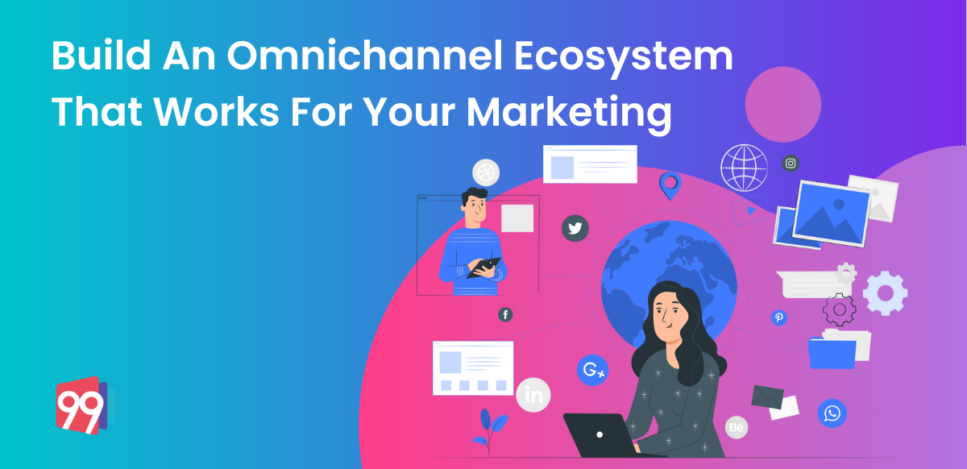Creating an omnichannel ecosystem can help businesses ramp up their ROI and approach marketing nuancedly. Innovation in marketing is easier said than done. Many companies keep looking for paths to increase audience interaction and ease customer journeys. On the other hand, consumers are always looking for brands that provide a seamless user experience and high accessibility.
Though many companies are moving toward digital transformation, the change from reality to the virtual world in staff and customer targeting is still pending. Small businesses and retailers must build brand reputation and recognition across various channels to attract audiences. While marketers consider multichannel marketing a solution to this problem, it does not cater to establishing a unique buyers’ journey for users.
In this blog, we will explore how setting up an omnichannel ecosystem can solve the creating a seamless user experience across channels. We will learn about its benefits and how every business must use it to increase conversions.
But before, let’s understand some basic concepts.
What is Omnichannel Marketing?
An omnichannel ecosystem is a digital marketing strategy that allows businesses to interact with customers on multiple channels. Brands do it through websites, apps, social media, and other digital platforms. By having a unified system, businesses can provide a better customer experience and increase their chances of converting leads into customers.
Omnichannel marketing aims to create a coherent brand experience across channels and create value from every customer interaction with a company.
Multichannel marketing aims to increase brand awareness by being present on various platforms. The content on these channels is not correlated. No company wants to be lost in the feeds of prospects. To stand out, brands must network buying experience across platforms. Spanning customer journeys across channels for customer acquisition or retention is crucial.
Although an omnichannel ecosystem is integral to digital marketing, every business must take different steps to make it work for them. Small businesses need to focus on developing strong brand reputations across various channels. Retailers must create easy-to-use interfaces so customers can visit the site or app without difficulty. Social media platforms like Facebook and Twitter must be well planned to reach as many people as possible. Large companies may not have trouble setting up an omnichannel ecosystem, but they may want to consider doing so in phases so that it does not overload their systems with traffic.
Building an omnichannel ecosystem can be challenging, but the rewards are worth it! According to stats, omnichannel ecosystems for customer engagement give retention rates of up to 89%. Businesses that use this strategy tend to have higher conversion rates and more loyal customers who are more likely to return in the future.
Benefits of Omnichannel Ecosystem in Marketing
The omnichannel ecosystem is a model for designing and delivering customer experiences that span multiple channels, including online, mobile, social media, and physical stores. They serve personalised experience to potential customers essential for lead nurturing. Let’s understand what other benefits an omnichannel ecosystem brings in:
– Increased customer loyalty and satisfaction
An omnichannel ecosystem creates an environment where customers have various channels and devices regularly interacting with a brand. It leads to increased customer loyalty and satisfaction, as customers can access the products they need when needed and in the most comfortable manner. In addition, omnichannel ecosystems help companies reduce customer service costs by providing more immediate support through digital channels.
– Access to Better Consumer Data
Providing excellent customer service is a priority for all companies. As omnichannel is spread across various channels, tracking user interactions with the brand becomes easier than just relying on websites and emails. It allows companies to analyse customer behaviour and tweak it as needed to keep customers returning.
– Creates a Solid Brand Value
An omnichannel ecosystem creates a solid brand value by providing an increasingly diversified range of customer experiences. It reinforce the company’s overarching message and differentiate it from its competitors. By engaging customers in multiple channels, omnichannel companies can build trust and create loyal customers more likely to recommend their product or service to others. Omnichannel ecosystems also allow companies to react quickly to changes in the marketplace and adjust their marketing efforts accordingly. In short, an omnichannel ecosystem creates a solid brand value by providing a comprehensive customer experience across all channels.
Steps To Create an Omnichannel Ecosystem
Step 1: Define your business goals
It is essential to figure out the business goals to develop a network of channels where the brand message is loud and clear. What specific objectives do you want to achieve through your omnichannel ecosystem? Once you have a clear idea of what you want, it’s easier to develop a strategy for achieving it.
Step 2: Assess customer behaviour
Understanding how customers interact with your services is crucial to making the most effective channel decisions and tailoring your brand messaging accordingly. It involves surveying customer feedback data, observing customer behaviour in real-time, and analysing social media posts.
Step 3: Determine what channels are best for reaching your target customers (Most Essential Step)
There is no one-size-fits-all answer to this question, as the best channels for reaching your target customers will vary depending on your product, service, and target market. However, there are a few key factors to keep in mind when determining which channels are best for you:
Your target market: Not all customers will be interested in using every channel available. For example, some people prefer to visit a physical store to purchase a product, while others prefer to buy products online. Accordingly, it is essential to know your target market and focus your marketing efforts accordingly.
Your product: Certain products are better suited for specific channels. For example, firms can sell software through websites or brick-and-mortar stores. It is essential to research which channels work best for your product before launching any campaigns.
Creating an omnichannel ecosystem that works for your company is a complex process that requires careful planning and execution. By understanding your target market, product, company and budget, you can optimise your marketing strategies for success.
Step 4: Design customer experiences across channels
It is also essential to design customer experiences across channels. So that customers feel they are engaging with the same company across all channels. It reinforces the brand message and builds trust with customers. In addition, it allows companies to personalise their interactions with customers according to their preferences and interests.
Step 5: Measure and optimise your marketing initiatives
As trends come and go, maintaining an omnichannel ecosystem becomes crucial. Creating a perfect omnichannel ecosystem in one shot is not possible. A rigorous analysis and optimisation exercise must occur to understand the underlying drivers of conversions. It will help form strategies for other campaigns as well. Companies must use A/B testing, landing page optimisation, heat maps, Google Analytics, etc., to conduct quality audits to focus on conversion rate optimisation.
Ending Note
With personalisation becoming a demand from the consumer side, brands can strengthen lead generation efforts by omnichannel marketing. Building an ecosystem of channels that work in and out to promote a company on various platforms is what omnichannel is all about.
By understanding its benefits, one can follow a step-by-step method to equip themselves with a complex yet effective strategy for simplifying brand recognition and lead generation.
Other Interesting Reads:
How To Use Omnichannel Analytics To Optimise Your Customer Experiences
Smart Marketing for Bookkeepers: Boost Your Client Base Now
Lead Generation for Travel Agents: Navigating the Path to Success in the Travel Industry
Featured Templates:





